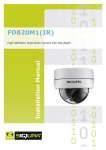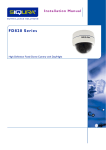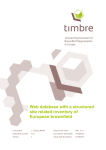Download Microsoft System Center Mobile Device Manager 2008
Transcript
System Center Mobile Device Manager 2008 The Case for Managing Mobile Devices using System Center Mobile Device Manager Sponsored by: Microsoft Authored by: Wipro Product Strategy & Architecture Practice October 2008 The information contained in this white paper represents the current view of Microsoft Corporation on the issues discussed as of the date of publication. Because Microsoft must respond to changing market conditions, it should not be interpreted to be a commitment on the part of Microsoft, and Microsoft cannot guarantee the accuracy of any information presented after the date of publication. This white paper is for informational purposes only. MICROSOFT MAKES NO WARRANTIES, EXPRESS, IMPLIED, OR STATUTORY, AS TO THE INFORMATION IN THIS DOCUMENT. Complying with all applicable copyright laws is the responsibility of the user. Without limiting the rights under copyright, no part of this document may be reproduced, stored in or introduced into a retrieval system, or transmitted in any form or by any means (electronic, mechanical, photocopying, recording, or otherwise), or for any purpose, without the express written permission of Microsoft Corporation. Microsoft may have patents, patent applications, trademarks, copyrights, or other intellectual property rights covering subject matter in this document. Except as expressly provided in any written license agreement from Microsoft, the furnishing of this document does not give you any license to these patents, trademarks, copyrights, or other intellectual property of Microsoft. Unless otherwise noted, the example companies, organizations, products, domain names, e-mail addresses, logos, people, places and events depicted herein are fictitious, and no association with any real company, organization, product, domain name, email address, logo, person, place or event is intended or should be inferred. ©2008 Microsoft Corporation. All rights reserved. Microsoft, Active Directory, Exchange Server, SQL Server, System Center Mobile Device Manger, Windows Mobile, Windows Server Update Service are trademarks of the Microsoft group of companies. The names of actual companies and products mentioned herein may be the trademarks of their respective owners. Managing Mobile Devices using System Center Mobile Device Manager 2008 Table of Contents Executive Summary 3 Introduction 4 Background 4 Research Approach 4 Total Cost of Ownership Analysis 5 TCO Calculator Model and Data 5 TCO Example: MDM v. RIM BES 4.1 6 Infrastructure-related TCO Savings 7 Management-related TCO Savings 8 MDM Greenfield v. RIM Brownfield Scenarios 9 Conclusion & Recommendations 10 About Wipro Product Strategy & Architecture Practice 11 Table of Figures Figure 1: TCO for MDM and RIM BES 4.1 Solutions over One (1) and Three (3) Years 6 Figure 2: MDM v. RIM: MDM TCO Savings by Source 7 Figure 3: MDM and RIM Deployment Costs 9 Wipro Product Strategy & Architecture Practice Managing Mobile Devices using System Center Mobile Device Manager 2008 Executive Summary By year-end 2011, IDC expects nearly 75% of the U.S. workforce will be mobile. This whitepaper is written to help Technology Decision Makers (TDMs) understand how Microsoft’s System Center Mobile Device Manager (MDM) can help lower the complexity and cost of managing their organization’s mobile devices. Microsoft retained Wipro to conduct primary market research to identify and quantify the benefits corporations realize from using MDM to manage Windows Mobile devices. These research results have been combined with publicly available pricing data and configuration guidelines to develop a Total Cost of Ownership Calculator (TCO Calculator) for MDM and other competing mobile device management products, including RIM Blackberry Enterprise Server 4.1. To gather the relevant operational data, Wipro interviewed IT Professionals (IT Pros) from 100 North America corporations that manage 500 or more mobile devices using a variety of mobile device management products, including MDM. Wipro used the research results to compare the economics of existing mobile device management deployments with MDM-enabled solutions. The results of this research study are reflected in Microsoft’s MDM TCO Calculator, which was developed by Alinean and can be found at https://roianalyst.alinean.com/microsoft/mobile/launch.html. Wipro used the TCO calculator to estimate and compare the 1 and 3 year lifecycle costs of deploying and supporting MDM to mange mobile access to Microsoft Exchange Server 2007 with a comparable RIM Blackberry 4.1 solution in both Greenfield and Brownfield examples. In the Greenfield example, each solution was used to support six mobile device deployments ranging from 2,500 to 15,000 mobile devices. The MDM three year TCO was projected to be approximately 40% less than the RIM TCO for all six deployment scenarios and 32% less in the one year TCO. In the Brownfield example, a corporation was presumed to have an existing number of Blackberry mobile devices being managed by a BES and had plans to expand the number of mobile devices. In this “cap and grow” example, the one year TCO that added an MDM configuration to manage just the additional mobile devices was less than the RIM expansion costs, without considering the corresponding increased Management costs. In the MDM scenario, the new mobile devices would be Windows Mobile devices rather than Blackberry mobile devices. In these examples, MDM has a lower TCO than RIM BES 4.1 because of the following factors: • Reduction in software licensing costs • Elimination of annual per-device maintenance costs • Reduction in server and storage requirements (including facilities costs) • Reduction in mobile device planning, enrollment and provisioning labor • Reduction in mobile device management and administrative labor Wipro Product Strategy & Architecture Practice page 3 of 11 Managing Mobile Devices using System Center Mobile Device Manager 2008 Introduction This whitepaper is written to help Technology Decision Makers (TDMs) understand how Microsoft’s System Center Mobile Device Manager (MDM) can help lower the complexity and cost of managing their organization’s mobile devices. This whitepaper discusses the economic benefits of using MDM in terms of Total Cost of Ownership (TCO) and correlates the costs savings back to specific technical features or licensing characteristics. Background IT organizations are finding that managing mobile devices is becoming increasingly important and complex. By year-end 2011, IDC expects nearly 75% of the U.S. workforce will be mobile1. Mobile device applications have evolved from merely providing remote access to e-mail to enabling virtually all of the sophisticated applications traditionally found only on desktop computers. These applications include collaboration tools, unified communications, sales force automation, and Line of Business (LOB) applications. Remote workers are using mobile applications to access or generate some of their corporation’s most sensitive information. Supporting mobile devices requires all the traditional IT functions such as systems management, information security, and help desk. Currently mobile device management is performed on systems dedicated specifically to support mobile devices and provided little or no integration to existing systems management, security and support infrastructures. MDM allows IT organizations to manage mobile devices using the same systems management processes and infrastructure used to manage desktop and laptop computers. Research Approach Microsoft retained Wipro to conduct primary market research to identify and quantify the benefits corporations realize from using MDM to manage Windows Mobile devices. These research results have been combined with publicly available pricing data and configuration guidelines to develop a Total Cost of Ownership Calculator (TCO Calculator) for MDM and other competing mobile device management products, including RIM Blackberry Enterprise Server 4.1. To gather the relevant operational data, Wipro interviewed IT Professionals (IT Pros) from 100 North America corporations that manage 500 or more mobile devices using a variety of mobile device management products, including MDM. Wipro used the research results to compare the economics of existing mobile device management deployments with MDM-enabled solutions. This project also leverages previous research that supported an Alinean-developed TCO calculator that contrasts the TCO of using Windows Mobile and RIM to provided remote access to Microsoft Exchange (http://www.microsoft.com/canada/windowsmobile/wm07/business/strategy/tco.mspx) The results of this research study are reflected in Microsoft’s MDM TCO Calculator, which was developed by Alinean and can be found at https://roianalyst.alinean.com/microsoft/mobile/launch.html. 1 IDC Worldwide Mobile Worker 2007-2011 Forecast and Analysis (IDC #209813),January 2008 Wipro Product Strategy & Architecture Practice page 4 of 11 Managing Mobile Devices using System Center Mobile Device Manager 2008 Total Cost of Ownership Analysis The MDM TCO Calculator estimates the capital and operational costs related to provisioning, managing and supporting mobile devices to remotely access corporate e-mail2 in “greenfield” and “brownfield” scenarios for both MDM and other commonly deployed mobile management suites, including RIM Blackberry Enterprise Server 4.1. TCO Calculator Model and Data The TCO Calculator models total cost of ownership using fourteen (14) cost elements which are categorized as being either Mobile Device and Infrastructure (“Infrastructure”) or Mobile Device and Infrastructure Management (“Management”). The cost elements associated with Infrastructure and Management cost categories are provided in Table 1. Cost Categories in the TCO Calculator Mobile Device and Infrastructure (Infrastructure) Mobile Device and Infrastructure Management (Management) Mobile Devices Mobile Device Server Planning, Setup and Install Mobile Device Data and Voice Plans Mobile Device Provisioning / Enrollment Mobile Device Support and Maintenance Plans Ongoing Mobile Device Administration Mobile Device Server Infrastructure Hardware Mobile Device Server Admin and Support Mobile Device Server Storage IT Help / Service Desk Support Middleware, Device Mgmt and other Software IT Training and Learning Mobile Device Server Hardware Support Contracts Mobile Device Server Facilities and Overhead Table 1. TCO Calculator “Infrastructure” and “Management” Cost Categories The metrics used to calculate configuration information for MDM and competing products, including RIM Blackberry Enterprise Server 4.1, referred to as “Mobile Device and Infrastructure” in the TCO Calculator, were compiled by Microsoft and Wipro using prior research and other publicly available information. To quantify the relevant operational metrics, Wipro interviewed IT Pros or Technical Decision Makers from 100 North America corporations that manage 500 or more mobile devices using a variety of mobile device management products, including MDM. This information was used to estimate the amount of labor required to provision and manage mobile devices, support mobile device users, and train IT personnel. These cost elements are represented as “Mobile Device and Infrastructure Management” in the TCO Calculator. 2 T here are many mobile applications, in addition to e-mail, that could have been included in this research, but none are as ubiquitous as e-mail. MDM does manage mobile applications other than e-mail and, in fact, anecdotal survey feedback suggests that some of the most compelling TCO results came from corporations that had deployed industry- or company-specific mobile applications. Wipro Product Strategy & Architecture Practice page 5 of 11 Managing Mobile Devices using System Center Mobile Device Manager 2008 TCO Example: MDM v. RIM BES 4.1 Wipro used the TCO calculator to estimate and compare the 1 and 3 year lifecycle costs of deploying and supporting MDM to mange mobile access to Microsoft Exchange Server 2007 with a comparable RIM Blackberry 4.1 solution. In this example, each solution was used to support six mobile device deployments ranging from 2,500 to 15,000 mobile devices. To simplify the analysis, the total number of devices managed within each scenario did not increase during the 3 year period. The TCO analysis includes all of the Infrastructure and Management costs associated with deploying and managing each of the six deployment scenarios for 3 years. For the purposes of this analysis, Wipro assumed the costs of the mobile devices, the monthly recurring service plans for the mobile devices, and help desk support costs attributable MDM and RIM were equal. The projected TCO comparisons for the MDM and RIM solutions for each of the six deployment scenarios are shown in Figure 1 below. The MDM three year TCO was approximately 40% less than the RIM TCO for all six deployment scenarios and 32% less in the one year TCO. $8,000,000 $7,000,000 MDM $6,000,000 Blackberry $5,000,000 $4,000,000 $3,000,000 $2,000,000 $1,000,000 Projected 3 Year Total Cost of Ownership Projected 1 Year Total Cost of Ownership Total Cost of Ownership: MDM vs. RIM $8,000,000 $7,000,000 MDM $6,000,000 Blackberry $5,000,000 $4,000,000 $3,000,000 $2,000,000 $1,000,000 $0 $0 2,500 5,000 7,500 10,000 12,500 15,000 2,500 5,000 7,500 10,000 12,500 15,000 Number of Mobile Devices Supported Number of Mobile Devices Supported Figure 1. TCO for MDM and RIM BES 4.1 Solutions over One (1) and Three (3) Years MDM has a lower TCO than RIM BES 4.1 because of the following factors: • Reduction in software licensing costs • Elimination of annual per-device maintenance costs • Reduction in server and storage requirements (including facilities costs) • Reduction in mobile device planning, enrollment and provisioning labor • Reduction in mobile device management and administrative labor Wipro Product Strategy & Architecture Practice page 6 of 11 Managing Mobile Devices using System Center Mobile Device Manager 2008 Infrastructure-related TCO Savings Reductions in Infrastructure costs account for approximately 60% of the TCO savings and include reductions in software licensing fees, device maintenance and support fees, and server and storage costs. The majority of the infrastructure cost reductions is provided by the elimination of the mobile device maintenance and support fee, as shown in Figure 2. MDM Savings over RIM: by Category TCO Savings over 1 Year 25% TCO Savings over 3 Years 9% 19% 36% 40% 28% 13% 13% 6% 8% SW Licenses Maint. and Support Servers Device Provisioning Management/Ops Figure 2. MDM v. RIM: MDM TCO Savings by Source The RIM solution has a licensing model that assesses annual maintenance fees on servers and on each mobile device under management. The RIM TCO included maintenance and support costs based on RIMs T-Support level 4, which was discounted based on RIM’s published volume price discounts. MDM does not have a comparable per device maintenance or support fee and the resulting savings accounts for 28% of the 1 year TCO savings and 40% of the 3 year TCO savings. The RIM server configuration assumed a Blackberry Enterprise Server would be required for every 1,300 mobile devices. The RIM server configuration also included additional Microsoft SQL Servers3 and storage; although technically required, the solution did not include the additional Exchange Back End Servers unique to this particular application. The server-related costs included the cost of the hardware, storage, hardware maintenance, and facilities. The MDM solution supported up to 15,000 users and was based on a three server configuration that consisted of a gateway server, enrollment server and DM server. At 10,000 users, the number of gateway servers was increased from three to seven. Server-related cost savings represented 14% to the 1 year TCO and 8% to the three year TCO. The remaining infrastructure savings reflects MDM’s lower software licensing fees relative to RIM. Software license fee savings accounted for 19% of the one year TCO reduction and 9% of the three year TCO reduction. 3 revious Wipro research found that RIM solutions that provide mobile access to Microsoft Exchange Server places additional burden on the underlying Microsoft SQL P database that requires an additional SQL server for every 3,400 blackberry devices supported. Wipro Product Strategy & Architecture Practice page 7 of 11 Managing Mobile Devices using System Center Mobile Device Manager 2008 Management-related TCO Savings Survey results indicated that MDM administrative labor required to perform tasks such as device enrollment, provisioning, and maintenance is significantly lower than that required by competitive solutions. One of the IT Pros interviewed is a current MDM administrator and had previously been a RIM BES administrator. The respondent reported that MDM reduced his operational administrative labor hours by a ¼ FTE for every 500 mobile devices managed. He also expected mobile device administrative efficiency to further increase as his corporation deployed additional mobile applications to the workforce. As shown in Figure 2, reductions in Management costs attributed for approximately 40% of the MDM TCO savings when compared to RIM. The majority of the management cost saving are derived by the reduced labor required to administer mobile devices after the devices have been enrolled and provisioned. This reduction accounted for 25% of the TCO savings over 1 year and 36% savings over 3 years. The remaining savings resulted from a reduction in labor required to plan, install and deploy mobile device servers and enroll and provision mobile devices. Microsoft has engineered MDM as an extension to existing IT systems management tools, such as Active Directory and Windows Server Update Service (WSUS), specifically to help IT organizations streamline the processes require to manage mobile devices. These survey results validate Microsoft’s approach. Wipro Product Strategy & Architecture Practice page 8 of 11 Managing Mobile Devices using System Center Mobile Device Manager 2008 MDM Greenfield v. RIM Brownfield Scenarios The TCO Calculator calculates the total cost of ownership by categorizing lifecycle costs as being either “Infrastructure” or “Management”. As previously discussed and depicted in Table 1, Infrastructure costs are comprised of software licensing fees, device management and support fees, and server and storage costs. Management costs include Mobile Device Server Infrastructure Planning, Set up and Installation and Mobile Device Provisioning/ Enrollment. MDM vs. RIM, A case for Cap & Grow $7,000,000 One Year TCO MDM and RIM “deployment costs”—all of the capital and labor costs related to enrolling and provisioning additional mobile devices—can be estimated simply by re-categorizing mobile device planning and provisioning to become part of the infrastructure cost category. This re-categorization is shown in Figure 3 which recreates the one year TCO comparison of MDM and RIM using the six deployment scenarios and also shows RIM “deployment costs”. Note that the “deployment costs” are, by definition, less than the TCO. MDM TCO $6,000,000 RIM Deployment Cost $5,000,000 RIM TCO $4,000,000 $3,000,000 $2,000,000 $1,000,000 $0 2,500 5,000 7,500 10,000 12,500 15,000 Note that the RIM “deployment costs” are by Number of Mobile Devices Supported themselves consistently MORE than the MDM 1 year TCO. This infers that corporations with Figure 3. MDM and RIM Deployment Costs an existing RIM BES that are contemplating adding additional users could save money by employing a “cap and grow” strategy that provisions these additional users onto a new MDM system. This observation provides TDMs and IT Pros with additional flexibility when planning to add additional mobile devices to their legacy mobile device management systems. Consider the following example: a corporation currently has 2,500 Blackberry mobile devices being managed by a BES and is planning on expanding this configuration to add an additional 2,500 mobile devices. The TCO Calculator suggests that a “cap and grow” scenario whereby the additional 2,500 mobile devices are added to a new MDM configuration, leaving the existing 2,500 mobile devices to be managed by the legacy RIM BES is less expensive than the cost to simply adding capacity to the legacy BES to accommodate the additional 2,500 devices. In the MDM scenario, the new mobile devices would be Windows Mobile devices, rather than Blackberry mobile devices. This scenario works in large part because these new users would require new mobile handsets, and the procurement and provisioning costs of Blackberry devices and Windows Mobile devices are approximately equal. Wipro Product Strategy & Architecture Practice page 9 of 11 Managing Mobile Devices using System Center Mobile Device Manager 2008 Conclusion & Recommendations Microsoft’s MDM TCO was developed to help Technical Decision Makers and IT pros contrast the economic advantages of deploying MDM and competing products. The TCO Calculator results are based on publicly available pricing and configuration information, and operational metrics obtained from IT Pros from 100 North American corporations that manage 500 or more mobile devices. As part this analysis, the TCO Calculator was used to contrast the one and three year TCO for MDM and RIM BES to manage six configuration scenarios ranging from 2,500 mobile devices up to 15,000 Mobile devices in both Greenfield and Brownfield examples. In both Greenfield and Brownfield examples, MDM was shown to have a significantly lower TCO than RIM. In the Greenfield example, the MDM was approximately 40% lower than that RIM TCO for all six configuration scenarios. In the Brownfield example, a Greenfield MDM deployment that “capped and grew” an existing RIM deployment was shown to have a lower TCO resulting from expanding the existing Brownfield RIM expansion. In fact, in the Brownfield example, the MDM TCO was less than the costs to expand the RIM solution, even without considering the resulting increased RIM management costs! Wipro Product Strategy & Architecture Practice page 10 of 11 Managing Mobile Devices using System Center Mobile Device Manager 2008 About Wipro Product Strategy & Architecture Practice The Wipro Product Strategy & Architecture (PSA) practice is a division of Wipro Technologies, a global technology services division of Wipro Ltd. (NYSE-WIT). Wipro’s PSA practice has more than 12 years experience in researching, analyzing, and documenting the business value of technology solutions. Wipro’s PSA practice helps enterprises and technology vendors develop innovative and effective product and IT strategies that enable them to expand their market opportunities, extend their competitive advantage and economize their business operations. In addition to consulting to technology vendors, PSA practice consultants and technologists work with global enterprises and service providers in architecting and implementing large-scale systems. This practical hands-on experience gives Wipro’s PSA practice consultants and technical architects first-hand knowledge that informs their business analysis work. For more information about Wipro’s PSA practice, please contact Theo Forbath at [email protected]. ©2008 Microsoft Corporation. All rights reserved. Microsoft, Active Directory, Exchange Server, SQL Server, System Center Mobile Device Manger, Windows Mobile, Windows Server Update Service are trademarks of the Microsoft group of companies. The names of actual companies and products mentioned herein may be the trademarks of their respective owners.. Wipro Product Strategy & Architecture Practice page 11 of 11




















